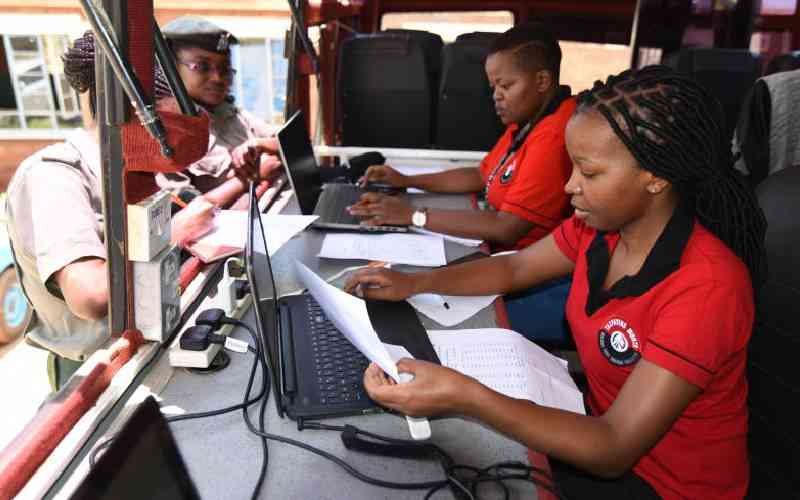By Patrick Beja
The construction of the Mombasa second container terminal is set for commissioning by the end of November.
The Sh28 billion project is expected to boost efficiency and reliability of the port that has over time caused uproar during container upsurges usually experienced during the December-January festive season.
Kenya Ports Authority (KPA) managing director Mr Gichiri Ndua announced the plans last week and said it would see the port increase its handling capacity and enhance container operations.
KPA has been forced to transfer containers on arrival to private container freight stations (CFSs) to manage congestion at the port.
“The authority is scheduled to commission the construction of the second container terminal by end of November this year. This will see the port increase its handling capacity and enhance our container operations,” Ndua explained.
President Kibaki is expected to preside over the commissioning. Ndua said this was in addition to a number of projects towards vital infrastructure investment and equipment upgrading to expand capacity to accommodate current volumes and future growth.
More employment
Ndua spoke when he launched the ethics code, anti-corruption and anti-fraud policies at Whitesands Beach Resort. He was flanked by general managers Mr Salim Chingabwi,Ms Muthoni Gatare and Ms Catherine Wairi.
With a capacity of 1.2 million Twenty Foot Equivalent Units (Teus) per year, the new terminal is expected to generate at least 1000 jobs directly and close to 4,000 indirectly.
“The increased port capacity will attract new shipping lines to route their vessels to Mombasa and as such create more business in the shipping fraternity hence more employment and revenue for the government,” Ndua said.
This is the largest single project being undertaken by the KPA since 1980 when the current container terminal was built. The second container terminal is part of the expansion and modernisation programme of the port.
The terminal will further enhance trade facilitation and economic development of the region and Africa as a whole.
The project involves the dredging of the main channel, land reclamation of 100 hectares, construction of three berths with a straight-line quay of 900 meters and creation of space for container stacking and supportive facilities.
To ease container off-take from the port, a new access road and a railway line will be constructed to link the container terminal and the existing port network on one end and the proposed Dongo-Kundu by-pass and Mombasa - Nairobi Highway on the other end.
Equally essential will be the procurement of container handling equipment including Ship to Shore Gantries, Rubber Tyred, and Rail Mounted Gantry cranes. The total cargo volumes through Mombasa port have steadily increased at an average rate of 11.6 per cent between 2000 and 2011.
Dramatic growth
Between 2010 and 2011, container throughput grew by 10.8 per cent compared with global average of 7.1 per cent.
The first six months of 2012 witnessed a more dramatic rate of growth of 22 per cent when compared to similar period last year; it rose from 479,000 to 585,000 teus.
The current container terminal was built in 1980 with a designed capacity of 250,000 Teus. The port has over the years through initiatives and creativity generated additional container capacity by converting conventional cargo berths, demolishing quayside sheds and introducing private CFSs to meet demand for the increasing container traffic.
However this has only partially addressed the problem and the port continues to face capacity constraints and delays during traffic upsurges.
Joint agreement
The container traffic through the Port of Mombasa is projected to reach 960,000 Teus by 2015. This will happen when the container handling capacity within the existing port will be about 1million Teus.
The project is funded by a Japan Government loan through Japan International Co-operation Agency within the Special Terms for Economic Partnership (STEP) at an interest rate of 0.2 per cent (except for consultancy services, that will have an interest rate of 0.01 per cent) and a repayment period of 40 years including 10 years grace period.
The joint agreement between the governments of Kenya and Japan for the 26.711billion yen (Sh26 billion) loan was signed in November 2007. On its part, the Government through KPA is to invest the complementary funding of Sh5 billion plus provision for compensation of the project affected persons at Sh612 million.
 The Standard Group Plc is a multi-media organization with investments in media
platforms spanning newspaper print operations, television, radio broadcasting,
digital and online services. The Standard Group is recognized as a leading
multi-media house in Kenya with a key influence in matters of national and
international interest.
The Standard Group Plc is a multi-media organization with investments in media
platforms spanning newspaper print operations, television, radio broadcasting,
digital and online services. The Standard Group is recognized as a leading
multi-media house in Kenya with a key influence in matters of national and
international interest.
 The Standard Group Plc is a multi-media organization with investments in media
platforms spanning newspaper print operations, television, radio broadcasting,
digital and online services. The Standard Group is recognized as a leading
multi-media house in Kenya with a key influence in matters of national and
international interest.
The Standard Group Plc is a multi-media organization with investments in media
platforms spanning newspaper print operations, television, radio broadcasting,
digital and online services. The Standard Group is recognized as a leading
multi-media house in Kenya with a key influence in matters of national and
international interest.









